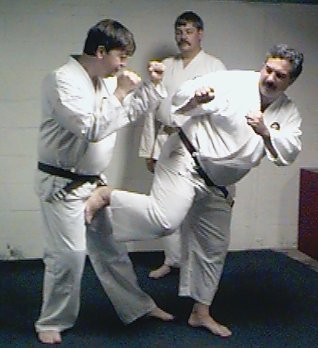Glad you find value in this stuff, PJW.
Another technique, this time for retention from the rear.
You are standing somewhere, perhaps observing an event, a disagreement breaks out with a local thug. You stand there, talking to him, when his partner comes from behind you, attempting to seize your weapon. As with all of the other techniques, if your attacker is trying to take the weapon with one hand, you can be sure he'll probably be pummeling you with his free hand. If he's using both of his hands, you've got all of his strength to contend with, when retaining your weapon.
For the exercise:
Stand with feet shoulder width apart, as before.
Your training buddy is behind you, facing you in the same way. He's a little less than arm's length away.
He lunges forward and grabs your holstered weapon with his right hand, or with both hands (train alternatively either way),
attempting to withdraw it from the holster.
Immediately place your drawing/strong hand on TOP of his grasping hand and push down, as before, trapping his hand on top of the weapon, and forcing it to stay put, in the holster.
As you are placing your trapping hand down on the grasping attacker's hand, drop your weight by 3 to 6 inches, by bending your knees, and lean at the torso, towards the weapon. Even if your attacker is stronger than you are, he won't be able to drive the pistol up and out, as your upper torso will physically be blocking it from sliding upwards.
Now, quickly mate your
weak/non-draw hand on top of your strong hand, to add additional downwards force, and more firmly secure the weapon.
At this point, you are standing with your knees bent (lowered center of gravity), both hands on top of your attacker's hand(s) with the weapon on your hip and firmly seated in its holster. Your opponent is either pulling your weapon, trying to jerk it out of its holster, or he is trying to release you and get away. His free hand (if he didn't go for the weapon with BOTH hands) is striking you, probably on the back of your head. Your instinctive crouch may afford a tiny bit of protection, but not much.
Using your strong/drawing hand, release the holstered weapon (KEEP YOUR WEAK HAND ON TOP OF THE PISTOL and deliver several (3, 4 or even 5) quick, powerful elbow strikes to your attacker's head. Keep striking until his grip is released from the holster.
As SOON AS THE GRIP RELEASES, pull him across your body- using your weak hand, which should never have let go from its position on top of the holster, up until this point.
As you pull him forward and across your body, use your STRONG SIDE LEG to execute a "MULE KICK", straight back, attempting to drive the cutting edge of your heel through his knee. If you are physically inferior to him, or if you are not flexible, you may wish to attempt an alternative to this, which is driving your foot down on the arch of his foot. You want to stomp down hard enough to collapse a man-hole-cover.
After executing the mule kick/heel stomp, spin around facing him and push him away from you as hard as you can, using your palms against his torso.
Conduct immediate action (Tap Rack Bang) as described earlier.
Here's an illustration of a mule kick. Of course, for the purpose of the exercise, you'd be HOLDING his grasping wrist/hand/sleeves with your weak hand. Also, your intended target will be the knees/shins or alternatively, the arch of his foot.
A quick note
There may be several points, after the repeated elbow strikes to the head, where you will be able to release your attacker, or where he may fall away from you, or pull free and retreat. If at any time, you can get some seperation between you and your attacker, perform IMMEDIATE ACTION (TAP RACK BANG).
**If you are able to disorient him using your elbow strikes, you must follow up immediately, as some people can recover from this disorientation within as little as 2-3 seconds.
.









